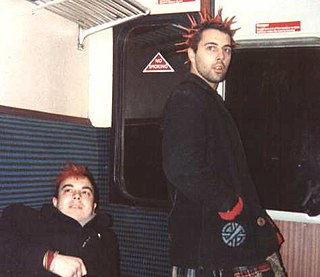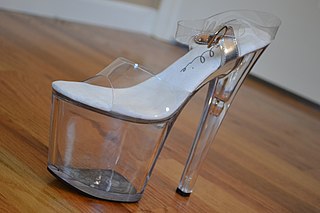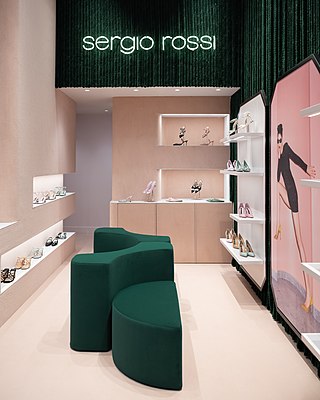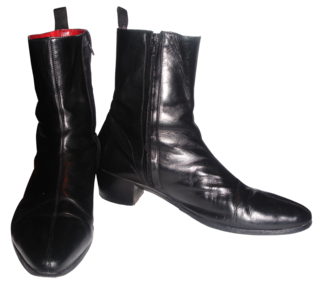
Footwear refers to garments worn on the feet, which typically serve the purpose of protection against adversities of the environment such as wear from rough ground; stability on slippery ground; and temperature.

Punk fashion is the clothing, hairstyles, cosmetics, jewellery, and body modifications of the punk counterculture. Punk fashion varies widely, ranging from Vivienne Westwood designs to styles modeled on bands like The Exploited to the dressed-down look of North American hardcore. The distinct social dress of other subcultures and art movements, including glam rock, skinheads, greasers, and mods have influenced punk fashion. Punk fashion has likewise influenced the styles of these groups, as well as those of popular culture. Many punks use clothing as a way of making a statement.

Sneakers (US) or trainers (UK), also known by a wide variety of other names, are shoes primarily designed for sports or other forms of physical exercise but which are also widely used for everyday casual wear.

Platform shoes are shoes, boots, or sandals with a thick sole, usually in the range of 5–10 cm (2–4 in). Platform shoes may also be high heels, in which case the heel is raised significantly higher than the ball of the foot. Extreme heights, of both the sole and heel, can be found in fetish footwear such as ballet boots, where the sole may be up to 20 cm (8 in) high and the heels up to 40 cm (16 in) or more. The sole of a platform shoe can have a continuous uniform thickness, have a wedge, a separate block or a stiletto heel. Raising the ankle increases the risk of a sprained ankle.

Sandals are an open type of shoe, consisting of a sole held to the wearer's foot by straps going over the instep and around the ankle. Sandals can also have a heel. While the distinction between sandals and other types of footwear can sometimes be blurry, the common understanding is that a sandal leaves all or most of the foot exposed.

Mule is a style of shoe that has no back or constraint around the foot's heel. Mules have a history going back to Ancient Rome but were not popularly worn until sixteenth-century Europe. There, mules were bedroom slippers and not worn in public. Through the centuries, mules have changed in style and purpose and are no longer just boudoir shoes but are worn at any time, for any occasion. In addition to Western examples, mules come from cultures such as Turkey and Egypt, and appear in popular culture, from famous paintings to iconic celebrities' shoes.

Sergio Rossi is an Italian fashion brand that focuses on footwear. Founded in Italy in 1951, the brand was later acquired by the Gucci Group in 1999. It became a part of the Kering Group under François Pinault, from 2005 until 2016, when Investindustrial fully acquired the brand. In June 2021, Fosun Fashion Group (FFG) announced that it had come to an agreement to acquire Sergio Rossi. The ownership was transferred to the Lanvin Group in October 2021.

Winklepickers or winkle pickers are a style of shoe or boot worn from the 1950s onward, especially popular with British rock and roll fans such as teddy boys. The feature that gives both the boot and shoe their name is the very sharp and long pointed toe, reminiscent of medieval footwear and approximately the same as the long pointed toes on some women's high-fashion shoes and boots in the 2000s. They are still popular in the goth, raggare and rockabilly subcultures.

Rockers are members or followers of a biker subculture that originated in the United Kingdom during the late 1950s and was popular in the 1960s. It was mainly centred on motorcycles and rock 'n' roll music. By 1965, the term greaser had also been introduced to Great Britain and, since then, the terms greaser and rocker have become synonymous within the British Isles, although used differently in North America and elsewhere. Rockers were also derisively known as Coffee Bar Cowboys. Their Japanese counterpart was called the Kaminari-Zoku.

The Teddy Boys or Teds were a mainly British youth subculture of the early 1950s to mid-1960s who were interested in rock and roll and R&B music, wearing clothes partly inspired by the styles worn by dandies in the Edwardian period, which Savile Row tailors had attempted to re-introduce in Britain after the Second World War.

Chuck Taylor All-Stars or Converse All Stars is a sneaker manufactured by Converse. Initially developed as a basketball shoe in the early 20th century, its design has remained largely unchanged since its introduction. The shoe consists of a stitched upper portion, and a toe cap and outsole usually made of rubber. Although Chuck Taylors are made of various materials such as leather or suede, the original and most widely known version is made from cotton canvas. The innovative detail of the original shoe was the "loose lining" of soft canvas that was intended to provide flexibility and prevent blisters.

Engineer boots, also known as engineer's boots or engineering boots, are an American type of traditional leather work-boots. Their lace-less, rugged construction made them popular among motorcycle riders. Originally developed in the 1930s for firemen working on steam locomotives, the boots gained substantial popularity in the post–World War II era during a growing motorcycling culture. They became popular symbols of teenage rebellion in the 1950s and a common component of greaser wear. They were later adopted by skinheads and punks in the 1970s. By the 2010s, engineer boots were being popularly worn for fashion purposes, especially by non-traditional customers such as women, young urban professionals, and hipsters.

Fashion of the 1980s was characterized by a rejection of 1970s fashion. Punk fashion began as a reaction against both the hippie movement of the past decades and the materialist values of the current decade. The first half of the decade was relatively tame in comparison to the second half, which was when apparel became very bright and vivid in appearance.
Veldskoene ("FELT-skoona") or colloquially vellies ("FELL-ys") are South African walking shoes made from vegetable-tanned leather or soft rawhide uppers attached to a leather footbed and rubber sole by a method known as stitchdown construction, done without tacks or nails.

A Beatle boot or Baba boot is a style of boot that has been worn since the late 1950s but made popular by the English rock group the Beatles in the 1960s. The boots are a variant of the Chelsea boot: they are tight-fitting, Cuban-heeled, ankle-high boots with a sharp pointed toe. The style can feature either elastic or zipped sides.
Bodgies and widgies refer to a youth subculture that existed in Australia and New Zealand in the 1950s, similar to the rocker culture in the UK or Greaser culture in the United States. Most bodgies rode motorbikes but some had cars, many of which were hotted-up with accessories such as mag wheels and hot dog mufflers. Males were called bodgies and females were called widgies.

Chukka boots are ankle-high leather boots with suede or leather uppers, leather, wooden or rubber soles, and open lacing, with two or three pairs of eyelets. The name chukka possibly comes from the game of polo, where a chukka is a period of play.

A fashion boot is a boot worn for reasons of style or fashion. The term is usually applied to women's boots. Fashion boots come in a wide variety of styles, from ankle to thigh-length, and are used for casual, formal, and business attire. Although boots were a popular style of women's footwear in the 19th century, they were not recognized as a high fashion item until the 1960s. They became widely popular in the 1970s and have remained a staple of women's winter wardrobes since then.

Puma Suede is a line of shoes produced by Puma, with the first model released in 1968. The shoe is notable for being the first sneakers to use suede which at the time of its release was still considered a luxury material.


















